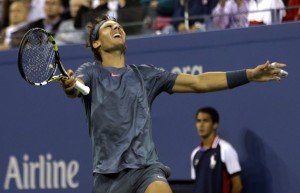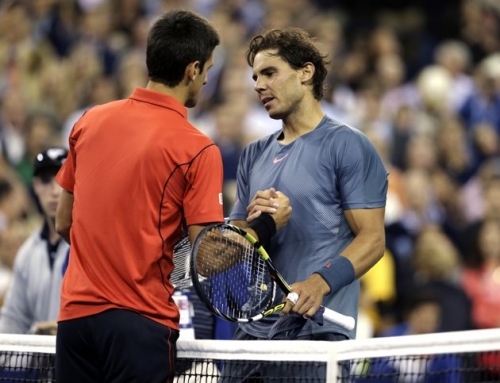 This time, the Monday final was deliberate. Since 2008, every US Open final has been pushed to Monday due to rain. This year, the weather held up enough that it could have been held on Sunday. However, the players had complained that the game had become so physical that the players needed a day of rest between the Saturday semis and the finals. While the other Slams put the semis on a Friday and use the Saturday as the rest day for the men, the US Open stands resolute in its insistence that the semis must be on a Saturday. It is expected to move to Friday in 2 years.
This time, the Monday final was deliberate. Since 2008, every US Open final has been pushed to Monday due to rain. This year, the weather held up enough that it could have been held on Sunday. However, the players had complained that the game had become so physical that the players needed a day of rest between the Saturday semis and the finals. While the other Slams put the semis on a Friday and use the Saturday as the rest day for the men, the US Open stands resolute in its insistence that the semis must be on a Saturday. It is expected to move to Friday in 2 years.
This break meant Novak Djokovic, who came off a 5-set win over Stan Wawrinka, had an additional day of rest which, in past years, wouldn’t have happened.
The match was scheduled for 5 PM Eastern time which is awkward because many folks on the East Coast have just gotten off work and most viewers on the West Coast are still in the middle of a workday. However, to hold an 8 PM final would mean the final might finish past midnight on the East Coast, and of course, the US being a football nation, such a final would interfere with Monday Night Football.
The final was a match that came in three parts.
Part 1 was Nadal coming fresh out of the gates, and Djokovic being flustered by the pace he was seeing from Nadal. John McEnroe would say that Djokovic didn’t look sharp, but honestly, compared to 2011, both Nadal and Djokovic are hitting a lot harder than they did before. Nadal took the first set, 6-2.
Part 2 was Djokovic upping his level of aggression, much like he did at the French Open. He was able to control rallies, and hit winners while Nadal scrambled helplessly. Djokovic got up a break, then got broken back with a sloppy game, then broke once again after a 54 shot rally, and finally held serve to take the set 6-3.
Part 3 was Djokovic trying to control the fourth set, having a 0-40 triple break opportunity to go up 5-4 and serve for the set, but unable to clinch the break, and then finding himself on the losing end of a service game, giving the set to Nadal, 6-4.
When that set was lost, Djokovic’s hopes seemed dashed along with the third set. Djokovic played aggressively, but unlike the second and third sets, where hard shots found their mark, they missed their mark in the fourth set, and Nadal was able to secure a relatively early break, and then secured a relatively late break, before closing out the final game handily, winning 6-1.
This match was played differently from their encounters back in 2011.
In 2011, Djokovic was content playing long, drawn out rallies, and not going for as big a shot as he does today. In those days, Nadal was also willing to trade long rallies with Djokovic. By being patient, Djokovic probed around, then would hit a big shot to end the point. Nadal spent a lot of time off after the 2012 Australian Open trying to add more aggression to his game, so that he could trade power shots against Djokovic. He did that well enough to win the French Open in 2012, but by Wimbledon, his knees were bothering him too much, and he took a 7 month break to recover.
Both Djokovic and Nadal changed how they wanted to play each other. Djokovic seemed to recall the pain that went into winning the 2011 US Open. He didn’t really recover until 2012, having to retire from a Davis Cup match and having several losses in London. Djokovic would come back to take the Australian Open in 2012 in a 6 hour marathon, played much like their previous 2011 matches.
Nadal felt he needed to go to the drawing board, and so he built a more powerful game. Djokovic, in the meanwhile, wanted to play more aggressively to avoid really long matches. He wanted to go for bigger shots. The drawback of being more aggressive is making more errors. Robin Soderling knows how that felt. In the finals of the 2010 French Open, Soderling pounded ball after ball, but Nadal fetched and looped and fetched and looped buying himself time. It seemed no matter how hard Soderling hit, Nadal could get his racquet on it can form a return.
In many respects, Djokovic tried to do the same, except he had more accuracy given that power. Even so, he coughed up over 50 errors, something Djokovic rarely does, but feels forced to do when playing Nadal.
Nadal used the slice backhand to good effect, keeping himself in points by slicing down the line. Occasionally, he would do weird things like hit a short ball or a drop shot, forcing Djokovic to the net, where typically Nadal would pass him.
Djokovic may have to rethink how he plays Nadal. A more aggressive style often breaks down as the match winds longer where Nadal seemed to keep his steady self with very little letdown. Djokovic defended Nadal better than any other player on the planet, but even his speed and flexibility wasn’t enough to deal with the errors he was prodigiously producing.
With this win, Nadal will have built up enough points that he should safely end the year at number 1, barring any injuries from now until then. Nadal remains undefeated on hard courts in 2013. He’ll probably play a limited hard court schedule the rest of the year, playing Shanghai, Paris, and London, and perhaps nothing else.
Despite the win, Djokovic will be number 1 for at least another few weeks, because he still holds about a 900 point lead over Nadal (it’s possible this lead is only 100 points because the main ATP site might not have added the winner points, but just the finalist points given the Monday final). At this point, every Nadal win closes this gap while Djokovic starts defending points once again in Beijing where he is defending champion.




![[US Open Men’s Final] Can Djokovic beat Nadal in the finals?](https://www.essentialtennis.com/wp-content/uploads/2013/09/20130909djokovic-500x383.jpg)
![[US Open, Semis] Djokovic and Nadal to play US Open final once again](https://www.essentialtennis.com/wp-content/uploads/2013/09/20130907nadal-500x383.jpg)
![[US Open, Day 11, QF] Wawrinka upsets Murray in straight sets to make first Slam semi](https://www.essentialtennis.com/wp-content/uploads/2013/09/20130906wawa-500x383.jpg)
![[US Open, Day 10, QF] Nadal shuts out Robredo to reach semis](https://www.essentialtennis.com/wp-content/uploads/2013/09/20130905nadal-500x383.jpg)